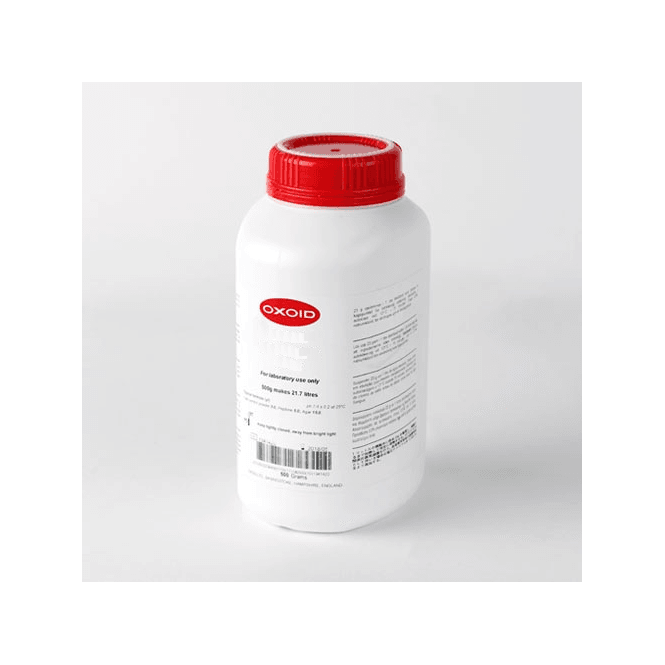Thermo Scientific™ Oxoid™ Thioglycollate Medium USP (Dehydrated)
Catalog No :
CAS Number :
Brand :
In Stock
Specifications:
| Application | Microbiology | ||
| Storage Temperature | Room Temperature | ||
| Product Type | Culture Medium | Forms | Powder |
| Product Brand | Thermo Fisher Scientific™ | ||
| Product Grade | Microbiology grade | ||
Thioglycollate Medium USP is a microbiological medium designed for cultivating both aerobic and anaerobic organisms. It is prepared according to the formula specified in the US Pharmacopoeia (USP) and adheres to the British, European, and Japanese Pharmacopoeias, making it suitable for sterility testing and microbiological quality control.
Key Features:
- Broad Application:
- Suitable for cultivating aerobic and anaerobic organisms.
- Effective for sterility testing, especially for injectable solutions and other products with potential bacteriostatic substances.
- Well-Buffered:
- Resistant to pH changes caused by acidic or alkaline reactions, maintaining the medium's effectiveness.
- Neutralizing Agent:
- Contains sodium thioglycollate, which acts as a reducing agent to neutralize the toxic effects of mercurial preservatives in solutions.
- Supports a Range of Organisms:
- Recommended for cultivating Clostridium species and other anaerobes.
- Sealey’s research highlighted its effectiveness in cultivating Desulfotomaculum nigrificans.
- Regulatory Compliance:
- Conforms to USP, BP, EP, JP, and ISO 11133:2014 standards for sterility testing and cultivation.
Preparation Instructions:
- Dissolve 29.6 g of medium in 1 liter of distilled water.
- Bring the solution to a boil to dissolve completely.
- Sterilize by autoclaving at 121°C for 15 minutes.
- Cool and store the medium at 2-8°C until ready for use.
Composition (Typical Formula):
| Component | Concentration (g/L) |
|---|---|
| Pancreatic Digest of Casein | 15.0 |
| Glucose | 5.5 |
| Yeast Extract | 5.0 |
| Sodium Thioglycollate | 0.5 |
| Sodium Chloride | 2.5 |
| L-Cystine | 0.5 |
| Agar | 0.75 |
| Resazurin Indicator | Trace |
| pH | 7.1 ± 0.2 at 25°C |
Microbiological Quality Control:
| Organism | Expected Result |
|---|---|
| Clostridium sporogenes ATCC® 19404 | Turbid growth with or without gas |
| Escherichia coli ATCC® 25922 | Turbid growth |
| Staphylococcus aureus ATCC® 6538 | Turbid growth |
| Uninoculated Medium | No growth (control) |
Appearance:
- Dehydrated Medium: Straw-colored, free-flowing powder.
- Prepared Medium: Light straw-colored gel with slight viscosity.
Storage and Shelf Life:
- Dehydrated Medium: Store at 10-30°C in a tightly sealed container.
- Prepared Medium: Store at 2-8°C, away from light and contaminants.
- Shelf Life: 5 years for the dehydrated medium.
Applications:
- Sterility testing for products, especially solutions containing bacteriostatic substances.
- Cultivation of anaerobic and facultative organisms, including Clostridium species.
- Monitoring microbial quality in pharmaceuticals and other sensitive industries.
Packaging Options:
- Catalog Number CM0173B: 500 g, yielding 16.9 liters of prepared medium.
- Catalog Number CM0173T: 5 kg for larger-scale applications.
Regulatory Compliance:
- Meets USP, BP, EP, JP, and ISO 11133:2014 standards for sterility testing and cultivation.
This product is a reliable choice for laboratories conducting sterility testing, supporting aerobic and anaerobic cultivation, and maintaining compliance with international quality standards.
Thermo Scientific™ Oxoid™ USP Alternative Thioglycolate Broth (CM0391B) vs. Thioglycollate Medium USP (CM0173B)
| Feature | CM0391B: USP Alternative Thioglycollate Broth | CM0173B: Thioglycollate Medium USP |
|---|---|---|
| Intended Use | Sterility testing for turbid/viscous products | General sterility testing |
| Formula Components | - L-cystine | - L-cystine |
| - Sodium chloride | - Sodium chloride | |
| - Glucose | - Glucose | |
| - Yeast extract | - Yeast extract | |
| - Pancreatic digest of casein | - Pancreatic digest of casein | |
| - Sodium thioglycollate | - Sodium thioglycollate | |
| No agar or resazurin | Includes agar and resazurin | |
| pH | 7.1 ± 0.2 at 25°C | 7.1 ± 0.2 at 25°C |
| Recommended Preparation | Dissolve 29g/L, sterilize at 121°C for 15 minutes | Dissolve 29g/L, sterilize at 121°C for 15 minutes |
| Preparation Notes | Must be freshly prepared or boiled and used within 4 hours | Can be stored for longer periods |
| Consistency | Liquid medium (no agar) | Slightly viscous due to agar |
| Key Applications | - Testing viscous/turbid products | - General sterility testing |
| - Culturing anaerobic and facultative microorganisms | - Culturing anaerobic and facultative microorganisms | |
| - Detecting flocculent or turbid growth | - Detecting growth through turbidity or visual indicators | |
| Key Features | - Non-viscous, suited for turbid inocula | - Includes resazurin as an oxidation-reduction indicator |
| - Requires fresh preparation or reheating immediately before use | - Agar component improves stability and facilitates anaerobic growth | |
| Quality Control | - Candida albicans ATCC® 10231: Flocculent growth | - Candida albicans ATCC® 10231: Flocculent growth |
| - Clostridium sporogenes ATCC® 19404: Turbid growth/colonies | - Clostridium sporogenes ATCC® 19404: Turbid growth/colonies | |
| - Peptostreptococcus anaerobius ATCC® 27337: Turbid growth/colonies | - Peptostreptococcus anaerobius ATCC® 27337: Turbid growth/colonies | |
| - No change in uninoculated medium | - No change in uninoculated medium | |
| Storage Conditions | Dehydrated: 10–30°C | Dehydrated: 10–30°C |
| Prepared: Use freshly or within 4 hours | Prepared: Store at 20–30°C, away from light | |
| Appearance | Dehydrated: Straw-colored, free-flowing powder | Dehydrated: Straw-colored, free-flowing powder |
| Prepared: Straw-colored solution | Prepared: Slightly viscous, straw-colored solution | |
| Key Advantage | Optimized for sterility testing in viscous or turbid biological products | General-purpose sterility medium with resazurin for easy visualization |
| Limitation | Requires immediate use after preparation | Less effective for viscous or turbid samples |
This table highlights the differences and similarities between the two Thioglycollate media types, helping users select the appropriate medium based on their specific application needs.




 0
0
